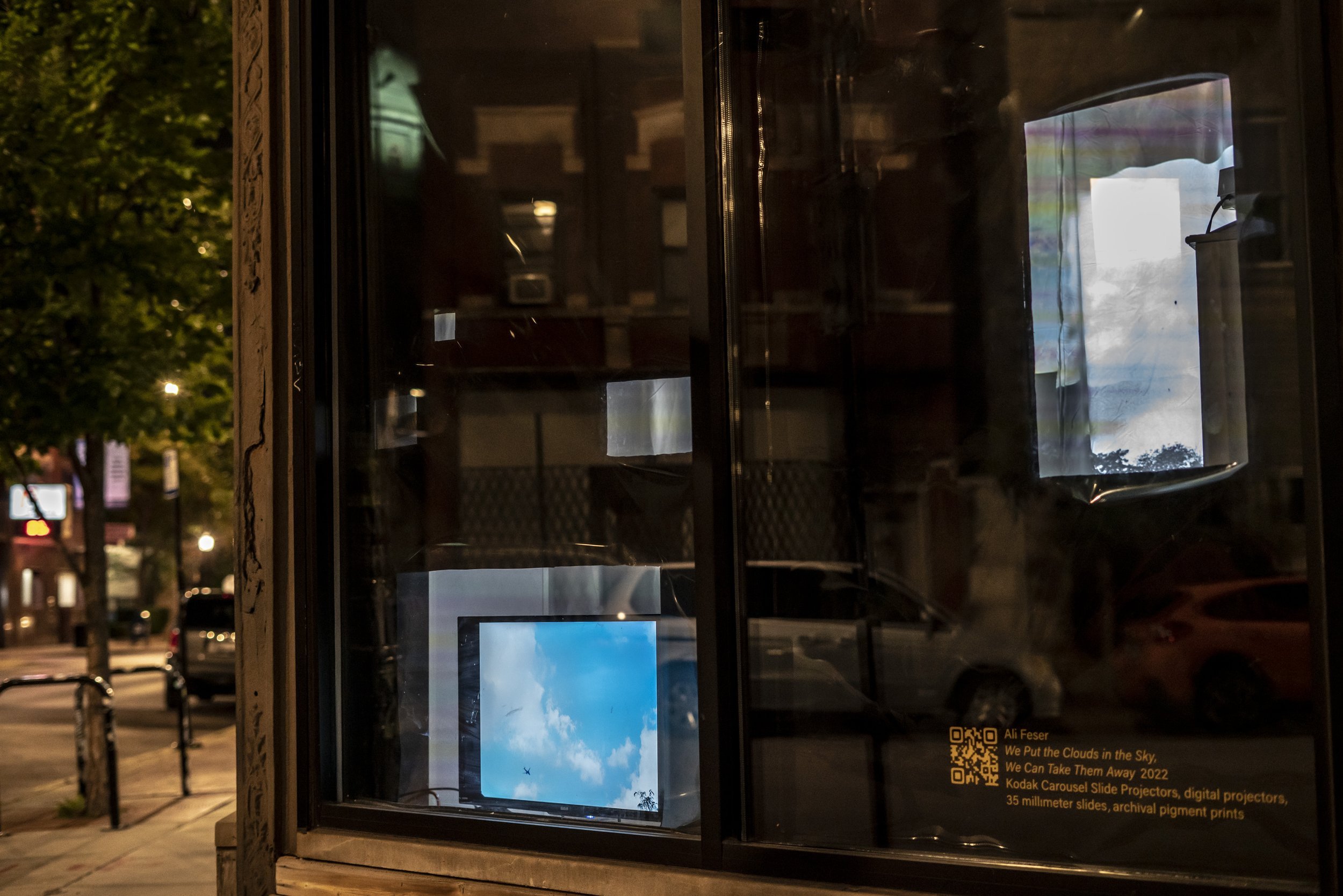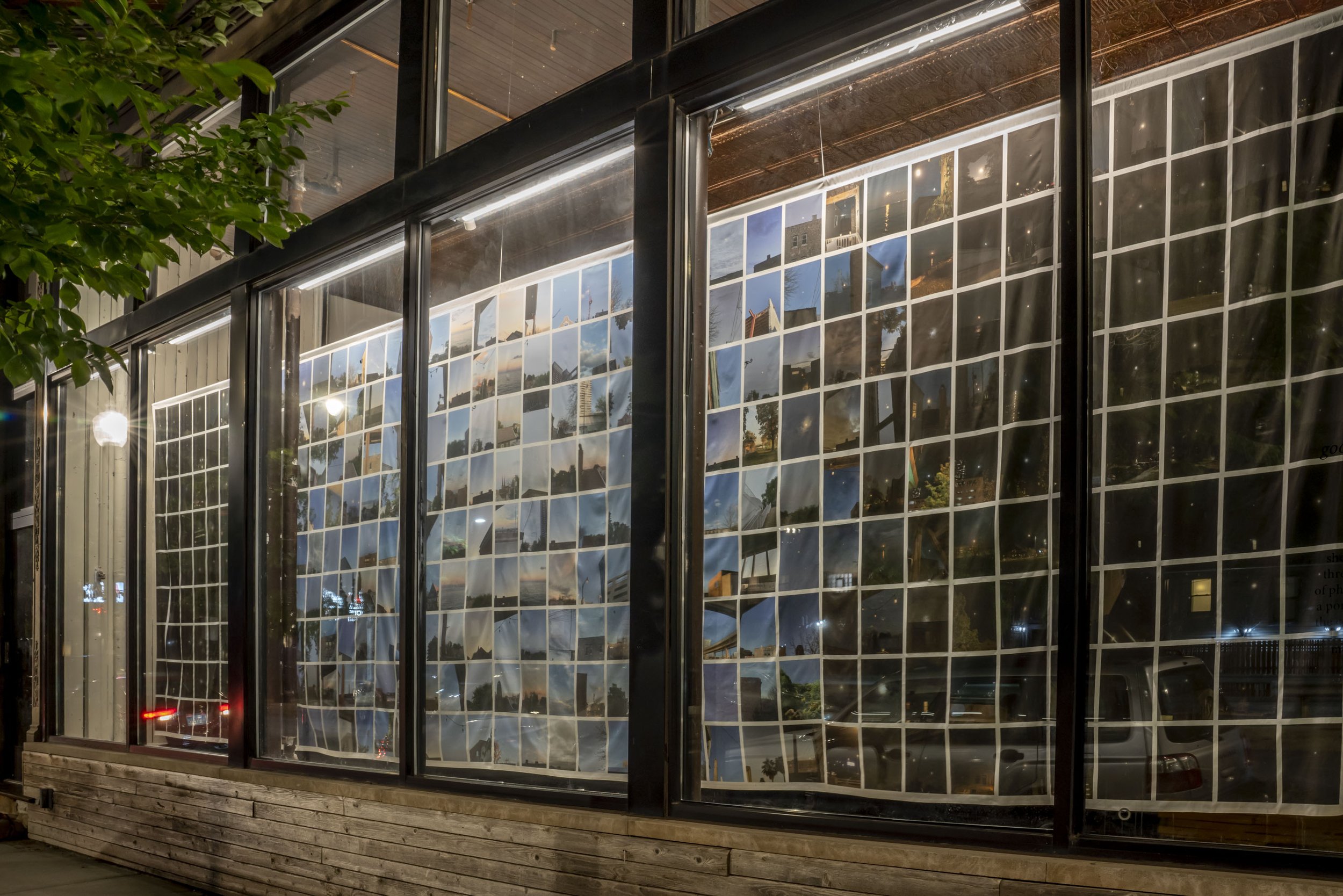The Nowness of Deep Needle Reminds Us We’re Alive
by Aricka Foreman
A lavender poster reads “Environment/ Must/ Resist/ This Fascist/ American/ Experiment,” facing West 32nd street on the corner of South Morgan. I ask Angela Davis Fegan about a phrase in her artist statement, how this location sits on a racial fault line.
The late afternoon light bends on the corner of her sunglasses, and stretches across the glass of the building where the letterpress posters—some of them sunbleached as we move closer to the Spring equinox— call out the persistent violence we know too well and keep having to survive through.
“There was a time Black folks couldn’t walk past Halsted without being harassed,” she said, and went on to point out some of the origin of the dried flora scattered just below the mixed media paintings.
By the mid-60s, my grandparents—having migrated from Mississippi—made their way North again, to a Black suburb just outside of Detroit called Inkster. While my grandmother's siblings, extended cousins and the like still live on the West Side, most of what I came to learn about Chicago came from someone I loved who already left.
The letterpress display comprised of handmade paper and book making material stacked with slogans that interrogate and make urgent calls the public can respond to: DEFEND/ BLACK/ LIVES/ DEFUND/ CPD; ACCESS TO TREATMENT IS/ FREEDOM/ DENIAL/ OF CARE IS/ VIOLENCE; RIOT/ MOBILITY/ SPECTRUM/ INTERSECTION; MY BODY IS/ UNGOVERNABLE/ AND ITS AGENCY/ CAN’T BE/ LEGI/SLATED. Yet in order for these demands to take root, they must be accepted as truisms in relation to our immediate experiences, knowing that more than one thing can be true at the same time.
But fixed just to this display’s left is an altar: apothecary jars of different shapes and sizes, filled with alchemy; dried eucalyptus and rose petals, splatters of fried and faded menstrual blood. All manner of preserved natural matter inside tequila, rum and whiskey bottles. This space is interior, tender and powerful: and kept uninterrupted behind the glass of the gallery.
Above it sits “Pilsen Window”, a 48’’ x 60’’portrait of the artist and a lover who reappears and pivots us between this move from slogan to activation and conjure, to these intimate pieces that face a street privy to neighborhood folks and visitors alike. And the portrait does the “swing-door” work of inviting those who pass through and those coming home to cross-paths where the fault line doesn’t have to exist if folks don’t want it to.
At night, the exhibition is lit in such a way, you get pulled into the text, into the texture and materiality you might miss, distracted by the glare and reflection of the day. Honestly, it’s at this hour where the work feels its most alive and urgent.
The eucalyptus branches on “Maya Fog: (2023) 24’’ x 36’’, rendered from a photo shot from the rooftop of the artist's print studio, seem to reach out like a hand while the figure in the piece is observed and preserved in time amongst the tall Summer grass. In an industrial-scape, this pause mimics a tender moment of fugivity.
“Gynecology” (2022) 30’’ x 15’’ absorbs and reflects so much texture and variance beneath the light, where its warmth forbids you to ignore how your desire to reach toward: vibrant paint, vegan leather, menstrual blood, paper prints on reclaimed wood. I found myself, tracing my fingers along the window though I knew I couldn’t reach it. The piece's composition does its subversion: a G-spot expansive through the gradient tonal hues in acrylic paint in flesh tones and left to dry in its suspended gravity, incorporating ephemera.
And that’s the tension. As evidenced in this nasty political race for Mayor, and this deeply persistent, communal struggle for liberation that folks forget about until they’re reminded of their desires for resistance; encountering “Deep Needle” requires us to apprehend a clear vision of freedom for everyone until we face what’s exclusionary in ourselves. And root out what does not work in a committed, everyday practice. It’s crossing paths and making room for one another. Dedicating ourselves to a rigorous “paying attention” in the advent of a hypervigilant surveillance state barreling down the tracks with fascists not only conducting the train but choosing alignment with the architects of the tracks.
We need a moment to sit with “Uterine” (2023) 24’’ x 36’’ and ask ourselves how we’re divinely connected, and how we show up to prove that old, multi-ancestral design we’re all tapped into if we listen and we don’t run. A possibility rooted in justice that prioritizes care, of seeing those who’ve we historically and consistently ignored and erased. And so I stood and soaked it in: this vulnerable and urgent, interconnected archive amidst small emblems of grief and healing. And the discipline that a better world exists so close we can touch it, if we tell it like it is and fight to make it clear.
And that this space for co-conspiracy is rooted in making a plan together. A constant in Angela Davis Fegan’s practice is accessibility, that art ownership doesn’t exist to merely serve the wealthy set on building their acquisitional portfolios. The public can take away letterpress calls for rebellion they can place in their homes from inside the Co-Prosperity space and share these objects with their communities. Leave their utterances and questions in lavender chalk on the bathroom wall. As Fegan notes “It creates a sense of precariousness that my experience can be erased at any time. My work is made to ensure that it will not be.”
And in doing so, the artist reminds us that we too are temporary. And we can make the most of our lives by pushing the silence at bay, by keeping it from forgetting ours and one anothers names.









